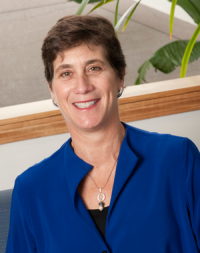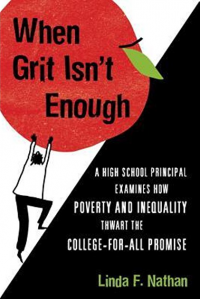How Inequality Thwarts the Promise of College for All
A new book explains how poverty and inequality put students at a disadvantage—and how we can better support them.
Four years ago, a high school senior from an Oakland charter school reached out to me to ask if I could help her apply to college. Jennifer was a first-generation student of Salvadoran and Guatemalan immigrant parents, a conscientious person with straight A’s at school.
Piece of cake, I thought, having already launched two daughters to college.

Over weekly coffees at Starbucks, we decided which colleges Jennifer would apply to and laid out a timeline of application tasks. Just to be sure, I passed her qualifications by a friend who is a professional college counselor.
“Aim for community colleges,” she advised.
Well, that’s a low bar, I thought to myself. Not very optimistic of her.
Jennifer was admitted to all of the University of California schools, and we were jubilant—and vindicated. Little did we know that getting into college was the easy part. Staying in was the hard part.
Jennifer’s student loan didn’t come through in time for her to take the supportive transition course during orientation. She felt unprepared for the overwhelming pace of work, and she suffered “imposter syndrome,” believing that she didn’t belong. She was intimidated by the prospect of talking to professors during office hours. She juggled a work-study job. She moved off campus to save money but had roommate hassles and the added burden of food shopping and preparation. By the end of her first year, she had failed a course and was placed on academic probation.
Jennifer is smart, and she was prepared to learn to navigate a whole new environment. But college was a tsunami of challenge. Fortunately, she found coaches and tutors to help her and continued to work hard. Jennifer will be graduating from the University of California this spring—the first in her extended family to do so.
Still, her earlier struggles were telling. If someone so promising—with so much “grit” and determination—had trouble making it, what does that say about our educational system?
When I read Linda Nathan’s new book, When Grit Isn’t Enough: A High School Principal Examines How Poverty and Inequality Thwart the College-For-All Promise, I had a shock of recognition. Nathan understands exactly how the cards are stacked against students like Jennifer.
Nathan has 38 years of experience in the Boston public schools and was the founding Headmaster of the Boston Arts Academy (BAA). At her school, roughly 80 percent of students are Latino or Black, and 71 percent qualify for free or reduced lunch—but more students apply, are accepted to, and graduate from college than the national average.
Drawing from this experience (more so than research), Nathan’s book is packed with insight and realistic solutions for anyone—especially high school educators, college and university counselors and coaches, vocational mentors, and more—who seeks specific suggestions for helping low-income and first-generation students succeed in college or careers.
Drawing from this experience (more so than research), Nathan’s book is packed with insight and realistic solutions for anyone—especially high school educators, college and university counselors and coaches, vocational mentors, and more—who seeks specific suggestions for helping low-income and first-generation students succeed in college or careers.
I spoke to Nathan recently about her book—and what students need, besides grit, in order to succeed.
Diana Divecha: What prompted you to write this book?
 Linda Nathan
Linda Nathan
Linda Nathan: After I stepped down from my position at the Boston Arts Academy, I interviewed alums of the school. I found that so many of the students didn’t succeed in college despite being so promising. In my first book, The Hardest Questions Aren’t on the Test, I tell the story of Shanita, who graduated top of her class at BAA. She got into her dream college with a full scholarship, but she never went. That has haunted me.
Students are made to believe that if they work hard and play by the rules, they will succeed—a promise that is failing them. Five assumptions or myths emerged from the stories of the students that especially harm low-income and first-generation college applicants: That when it comes to college, money and race don’t matter; that success comes from working hard; that anyone can go to college; and that if you just believe, your dreams will come true. These are just not true for everyone.
And I’m angry. I’m angry that we still haven’t got it right, and we’re asking the most vulnerable among us to figure out how to succeed when there are systemic inequities stacked against them. The privileged should be figuring this out for them. This isn’t a happy book—but all the royalties go back to the Student Activities Fund at BAA.
DD: What are some solutions to America’s failed promise to students?
LN: We’ve defunded guidance counselors in high school, and nonprofits are stepping in to help. But so far, the nonprofits tend to work alone. If they could get together and coordinate to give every rising senior an intensive week in August to help them figure out what they want to do next, to help kids apply to college, and so forth, it could change the course of America.
For college-bound seniors, there could be a week of college and career prep. In the summer between high school and college, nonprofits could coordinate for a week to make sure kids who’ve gotten in to college are actually putting together their packages and getting their last dollar of scholarships. Colleges need to coordinate with high schools to learn what kids need to succeed in the transition. And Thanksgiving is another pressure point; many students decide over the Thanksgiving break that they’ll do one more semester and then not go back. We need to catch them and say, “No, you can do it!”
DD: A lot of your solutions are systemic. What advice do you have for the students themselves who might come from poverty or are first-gen college applicants?
LN: Number one is, don’t you dare go where you don’t get money. You gotta go where the money is. And don’t take a year off—that’s fine for kids who come from privilege, but kids from challenging backgrounds who don’t go right away often won’t go at all. That’s why the service and the career exploration have to happen earlier in high school. At the school where I worked before BAA, kids do a six-week internship in the middle of their senior year.
DD: That’s great, because someone like Jennifer doesn’t have the luxury of exploring an unpaid internship later. She’s got to earn money.
LN: Exactly. That’s what enrages me. She should have had opportunities to explore careers in high school.
DD: In your book, you quote someone who compares “no excuses” discipline tactics—where students’ posture, attention, behavior, and even their dress are controlled through strict measures—to police brutality. What’s the problem with “grit”?
 When Grit Isn’t Enough: A High School Principal Examines How Poverty and Inequality Thwart the College-For-All Promise (Beacon Press, 2017, 200 pages)
When Grit Isn’t Enough: A High School Principal Examines How Poverty and Inequality Thwart the College-For-All Promise (Beacon Press, 2017, 200 pages)
LN: There’s nothing wrong with grit. It’s the way it’s been implemented, especially in charter schools, that’s wrong. The no-excuses movement [which enforces a strict disciplinary code], the SLANT mantra [Sit up, Look forward, Ask questions, Nod your head, Track the speaker]: They’re racist pedagogies, a sort of 1950s behavioral approach that is devoid of context. They make it seem like a student’s success is all individually accomplished, which is, of course, wrong.
You have to take into account race, social class, health, mental health, poverty. Just be grittier?! I’m waiting for the charter management organizations to issue a wholesale apology, to say, “We blew it, and we knew it all along.” Instead we should be helping students embrace their identities and navigate a racist and oppressive society.
DD: To what do you attribute BAA’s high persistence rate (percentage of students admitted to college who go on to graduate from college)?
LN: We do a ton in high school to prepare them for college. We feel it’s our job as teachers, not just the guidance counselor. It’s part of our curriculum to visit colleges, write college essays. We run an August institute to make sure everyone signs up for financial aid—you can’t graduate without it. We hired a retention specialist to support kids between graduation and the start of college. And we do a Thanksgiving program to support kids when they come back for break.
In most high schools, you graduate students and you’re done. And I’m saying to high schools, that’s not good enough.
DD: You question in your book whether college is right for everyone. For whom is it right, and what are the other options?
DD: You question in your book whether college is right for everyone. For whom is it right, and what are the other options?
LN: Career exploration has to be a part of education from middle school on, but, unfortunately, high-stakes testing has narrowed curriculum to a very limited diet of learning. High school should be an apprenticeship for life. It should offer career and technical training, along with opportunities for students to process and reflect on their experiences, so that, by graduation, students can make a decision: Do I want to be a forklift operator and go into construction, or do I want to do lab science which requires more training? Do I want a two-year degree, a four-year degree, do I want to join the military, is it possible to go right to work and make a living, or do I need more education and training?
America has dismantled what was formerly called vocational training. But there are great international examples. Switzerland has created apprenticeship programs for musicians, for child care workers, and for health care workers that are really good, so out of high school you can go the apprenticeship route or the four-year college degree. And it actually works! We could fund our community colleges more and make that route far more legitimate than it seems now.
I don’t think the mantra of “college for all” is right. We want young people to be able to live a decent life, have a living wage, and participate in democracy, and we’ve assumed the only way to get there is a four-year degree. That’s not the only way, and we need to create more paths from school to career.